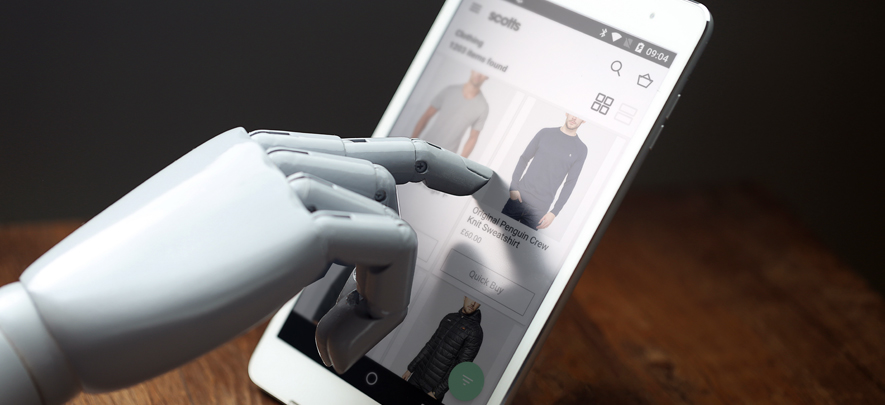AI could become your personal shopper

Digital & Technology
392 week ago — 9 min read
More retailers are turning to Artificial Intelligence (AI) to help shoppers find clothes that fit their bodies, budgets, and personal styles. As one of today’s hottest technology trends, AI translates vast volumes of retail data into rich, actionable insights so executives can make smart decisions faster.
AI has evolved into a strategic asset in retail even as the sector faces overwhelming upheaval. AI guides retailers by delivering fact-based intelligence to help them better serve shoppers. This gives retailers a leg up in a market full of empowered consumers who expect omnichannel excellence, affordable fashions, and personalised marketing.
The bottomline is that AI is the future of retail, and executives must learn how to leverage artificial intelligence technologies to compete in today’s market.
AI and retail: a perfect fit
Today’s retailers and brands are drowning in data. AI solves this problem by making sense of the abundance of information available and offering a cheaper, faster way of doing many of the tasks companies currently employ humans to do. This includes things like simplifying complex data analytics.
Companies also embrace AI to improve agility, performance, and customer service- all while lowering costs. Using AI technologies, retailers are able to achieve greater accuracy in predicting a consumer’s style at the exact moment that an individual is shopping. The augmented experience AI provides leads to more sales, fewer returns, and improved stocking ability.
These business benefits explain why 45 percent of retailers expect to implement AI to boost revenue within the next three years.
Taking shopping to the next level
Fashion retailers and brands can improve the customer experience by applying AI to extract data insights down to the individual shopper level. Whether a shopper’s look is casual chic, vintage-inspired, or haute couture, AI lets them perform easy product searches to find exactly what they’re looking for. For example, AI can help individual shoppers find the perfect pair of jeans by tracking their sales history, online browsing, and Instagram likes to provide a seamless shopping experience.
Here are seven examples of how AI innovations make life easier for fashion companies and fashionistas alike.
1. Finding the “look” faster
AI-driven visual search helps shoppers find their desired products quickly. An example of this is Pinterest’s visual search tool, called Lens. This tool uses machine vision to detect items on the web or in a Pinterest library and suggest related items. It’s like a ‘Shazam’ for clothing and accessories.
Neiman Marcus has another great example of this type of AI implementation. The high-end department store launched an AI-driven mobile app called “Snap. Find. Shop.” The app allows customers to use their smartphone cameras to take pictures of an item they like. Once it has an image for reference, the app displays similar items from the store’s inventory.
Some of the other major retail brands using visual search to provide a superior online shopping experience include Asos, John Lewis, Shoes.com, Nordstrom, and Urban Outfitters.
2. Providing hyper-personal product recommendations
A styling service called Thread combines AI and human touch to gather consumer insights. The brand distributes a questionnaire to find out more about each customer’s product preferences. The questionnaire even asks customers to upload images of themselves to provide more accurate product-matching. Once a questionnaire is submitted, a stylist reviews the information to understand each client’s needs and can then use the company’s AI algorithm to sort through thousands of products to provide personalised style suggestions.
IBM Watson implements a similar technology. The company partnered with The North Face to create a tool that asks shoppers questions about their product preferences to tailor product recommendations to individual consumer interests.
3. Implementing unprecedented omnichannel service
Farfetch, an online marketplace for luxury items, uses AI to improve supply chain visibility. AI helps Farfetch’s partners link their online inventories with the inventories of their physical stores. This allows them to deliver services like click-and-collect and in-store returns.
AI-driven bots also help retail companies engage consumers across channels like Facebook and Slack. A great example of this is the Messenger bot launched by Burberry during London Fashion Week. The bot allowed the brand to offer exclusive glimpses of their new collection before the runway debut. This included live customer service so users could even buy the clothes immediately.
4. Social selling
Pinterest launched “Shop the Look,” a machine learning tool that identifies pinned items shoppers can purchase. The items include fashions from multiple major retailers. The insightful data analytics from “Shop the Look” can be used to tell retailers when a sponsored post on the social media platform results in a sale.
5. Shopping like a personal stylist
The Hook team at Intelligence Node created an AI-generated fashion feed to give shoppers access to a mobile personal stylist. Hook learns what a shopper likes — in real time — by analysing which product images the individual has liked or added to their online wishlist. This lets shoppers find items they like more quickly. The app also sends shoppers real-time price drop alerts for items on their wishlists. The technology also implements a search function to find a specific item a shopper wants and compare prices and features among different brands. This helps consumers find the right item at the best price.
6. Spotting new trends
AI is used to crawl e-commerce sites to pinpoint exactly which products are most visible. This gives retail companies certainty on up-to-the-minute fashion trends. AI is also implemented in the process of crawling social media sites to identify trends. This helps brands be among the first to market their products with popular styles. An example of this is Intelligence Node’s retail crawling framework. It’s kind of like a “Google for fashion.” The system crawls more than one billion products from 130,000 brands in 1400 categories in real time. The technology uses AI and machine learning for image recognition to rapidly process and make sense of the abundant retail market data.
7. Setting the right price
Big data tools like Incompetitor help retailers maintain a competitive pricing strategy by combining AI and machine learning. Retailers integrate this API into a brand’s data so a rule-based engine can optimise prices based on real-time external factors, like inventory, competitors’ out-of-stock situations, and discounts. This integration allows retailers to optimise their prices. For example, AI technologies can be implemented to help retailers make sure they always sell a specific item for 10 percent less than Amazon.
The future of fashion
AI-driven tools help retailers gain a deep understanding of each shopper as a unique individual. They help retail companies identify a shopper’s size, preferred styles, colours, and price points. AI takes this combination of data and translates it into real-time intelligence that reflects product recommendations at prices that make the shopper more likely to add them to their cart. This deep consumer knowledge, matched with relevant products and affordable pricing, helps the shopper feel understood and more willing to buy.
Fashion companies should be injecting artificial intelligence into their business strategies to avoid falling behind during this period of digital transformation. Integrating advanced technologies helps the brands, retailers, and consumers all at once. AI simplifies retail data, which helps companies improve their processes and keeps shoppers happy, loyal, and most importantly, chic.
To explore business opportunities, link with me by clicking on the 'Invite' button on my eBiz Card.
Network with SMEs mentioned in this article
View Tullika 's profile
Most read this week











Comments (2)
Share this content
Please login or Register to join the discussion